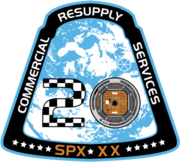SpaceX CRS-20
 Artist rendering of the SpaceX Dragon spacecraft being berthed to ISS | |
| Mission type | ISS resupply |
|---|---|
| Operator | SpaceX |
| COSPAR ID | 2020-016A |
| SATCAT no. | 45341 |
| Spacecraft properties | |
| Spacecraft | Dragon C22 |
| Spacecraft type | Dragon CRS |
| Manufacturer | SpaceX |
| Dry mass | 4,200 kg (9,300 lb) |
| Dimensions | Height: 6.1 m (20 ft) Diameter: 3.7 m (12 ft) |
| Start of mission | |
| Launch date | March 1, 2020 (planned)[1] |
| Rocket | Falcon 9 |
| Launch site | Cape Canaveral SLC-40 |
| Contractor | SpaceX |
| Orbital parameters | |
| Reference system | Geocentric |
| Regime | Low Earth |
| Inclination | 51.6° |
| Berthing at ISS | |
| Berthing port | Harmony nadir or Unity nadir |
| RMS capture | 2020 (planned) |
| Berthing date | 2020 (planned) |
 SpaceX CRS-20 mission patch | |
SpaceX CRS-20, also known as SpX-20, is a Commercial Resupply Service mission to the International Space Station planned to be launched in March 2020.[1] The mission is contracted by NASA and will be flown by SpaceX using a Cargo Dragon. This will be the last flight for SpaceX under the first phase of NASA's CRS-1 contract. A second phase was awarded in January 2016 and is expected to begin in 2020.
Launch schedule history
On February 2016, it was announced that NASA had awarded a contract extension to SpaceX for five CRS additional missions (CRS-16 to CRS-20).[2] On June 2016, NASA Inspector General report had this mission manifested for 2019,[3] but by June 2019 the launch had been pushed back to March 2020.[1] Exceptionally, anticoagulants will be sent to treat thrombosis of an astronaut in the ISS.
Primary payload
NASA contracted for the CRS-20 mission from SpaceX and therefore determines the primary payload, date of launch, and orbital parameters for the Cargo Dragon. According to a 2016 presentation, the external payload manifested for this flights is GEROS-ISS, which stands for GNSS reflectometry, radio occultation and scatterometry on board the International Space Station.[4]
See also
References
- ^ a b c "Launch Schedule - Spaceflight Now". Retrieved 18 January 2020.
- ^ de Selding, Peter B. (24 February 2016). "SpaceX wins 5 new space station cargo missions in NASA contract estimated at $700 million". Space News. Retrieved 24 February 2016.
- ^ NASA Office of Inspector General (June 28, 2016). NASA’s Response to SpaceX’s June 2015 Launch Failure: Impacts on Commercial Resupply of the International Space Station (PDF) (Report). NASA Office of Inspector General. p. 13. Retrieved 2016-07-18.
- ^ Kenol, Jules; Love, John (May 17, 2016). Research Capability of ISS for a Wide Spectrum of Science Disciplines, Including Materials Science (PDF). Materials in the Space Environment Workshop, Italian Space Agency, Rome.



